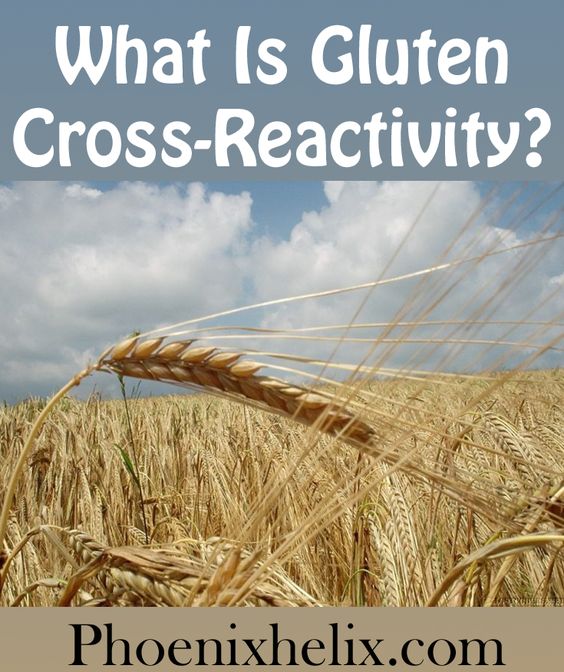“Experience without theory is blind, but theory without experience is mere intellectual play.”
~ Immanuel Kant
The Theory
Since many people with celiac disease continue to feel sick, even when they eliminate gluten from their diet, scientists have been looking for the reason why. One theory is cross-reactivity. What does that mean? When your body develops an allergy to gluten, it creates antibodies that remember gluten’s protein structure. If you eat gluten, those antibodies set off an inflammatory response. Some other foods have similar protein structures to gluten, and you may react to those as if they were gluten. It’s basically a case of mistaken identify. It’s important to note, however, that cross-reactivity isn’t something that happens to everyone. And very few people cross-react to all of the potential foods. It’s simply something to explore when giving up gluten isn’t enough.
Confusion About Which Foods Might Cross-React
There are many lists floating around the internet, and some have probably made their way into your news feed. They aren’t all accurate. In fact, I would say that most aren’t accurate. Why is that so?
Cyrex Labs has a blood test called Array 4, which is highly respected in the alternative health and paleo communities. It tests your blood against 24 foods for potential cross-reaction. Many people have typed up the Cyrex list into a graphic and circulated it around the internet (or reproduced it in articles on various websites). However, they usually simplify the list for easy viewing, and they drop some important details. For example, most lists say that chocolate is a cross-reactor, but if you look at Cyrex’s list, you’ll see they test milk chocolate, not dairy-free chocolate. This is because cocoa doesn’t cross-react; it’s the dairy that has the potential to cross-react. Here’s the Cyrex list: Gluten Grains (as a controlled comparison: rye, barley, spelt and polish wheat); Dairy (both whole milk and 4 isolated proteins); Milk Chocolate, Oats, Yeast, Coffee, Sesame, Buckwheat, Sorghum, Millet, Hemp, Amaranth, Quinoa; Tapioca (also called yuca and cassava); Teff, Soy, Egg, Corn, Rice, Potato.
However, Cyrex’s list isn’t necessarily accurate either. When it comes to science, studies published in peer reviewed journals (not private labs) are the benchmark. In fact, Sarah Ballantyne, author of The Paleo Approach, didn’t include any recommendations in her book that weren’t validated in the scientific literature. In 2013, the journal Food and Nutrition Sciences published a study which tested the Cyrex theory, to see if their list of foods really were potential cross-reactors. They even expanded their tests slightly. They went ahead and tested both cocoa and milk chocolate. They also tested regular coffee and instant coffee. Results? They found that only a small portion of the Cyrex list had cross-reactive potential:
- All Dairy (whole milk and every isolated protein)
- Milk chocolate (not cocoa)
- Instant coffee (not regular coffee)
- Oats
- Corn
- Millet
- Rice
- Yeast (brewers and bakers)
A Challenge to the Theory
In 2014, scientist Christina Graves, wrote an article for Paleo Foundation, entitled: 19 Gluten Cross-Reactive Foods: Busted Myth? Here are her assertions:
- Gluten cross-reactivity could only apply to people with celiac disease, not people who are simply sensitive to gluten, because only celiacs have circulating anti-gluten antibodies.
- The scientific study didn’t use rigorous testing or reporting standards, which weakens the validity of its findings.
- She doesn’t believe gluten cross-reactivity exists. However, she agreed that people with celiac disease might want to avoid the final list from the study for different reasons: (1) Lactose and casein (components of dairy) are common food allergens themselves. (2) Instant coffee, oats and millet are often contaminated with actual gluten. (3) Corn and rice can elicit other inflammatory reactions. (4) When it came to yeast, the authors of the study apparently said they didn’t know if they saw a true cross-reaction, or if their sample was contaminated with gluten. They used brewer’s yeast in the sample, which is often a byproduct of beer.
Christina Graves isn’t the only one to question the theory. Dr. Alessio Fasano is the Director of the Center for Celiac Research. He believes other food sensitivities are caused by leaky gut, and gluten cross-reactivity doesn’t exist.
How it Affects the Paleo Autoimmune Protocol
The Paleo Approach. Sarah Ballantyne includes information about gluten cross-reactivity in her book, The Paleo Approach. She follows the shorter list above, excerpted from the study published in Food and Nutrition Sciences. You’ll note that all of the foods in that list, with the exception of yeast, are excluded on the AIP already, for other reasons: The AIP is dairy-free, grain-free and seed-free.
What about Yeast? The authors of the study actually said they weren’t sure yeast was a cross-reactor; that their sample might have been contaminated with gluten. I also asked Sarah about this. She said that yeast cross-reaction is rare, and she feels that the benefits of fermented foods (which contain yeast) are more important to autoimmune healing than the minimal risk of consuming yeast. Therefore, yeast is allowed on the AIP, but if you don’t see positive results, you can eliminate that later as a potential troubleshooting step.
What about Tapioca? This is the most common question we are asked as AIP bloggers, when it comes to potential gluten cross-reactive foods. Although tapioca is listed on the Cyrex Array lab test, it wasn’t shown to be cross-reactive in the peer-reviewed study. For that reason, Sarah Ballantyne allows it on the AIP and you will see it in many recipes online.
Should We Ever Reintroduce These Foods? If gluten cross-reactivity exists, these foods are still only potential cross-reactors. That means reactions vary from person to person. None of the foods on this list are eaten on a strict paleo diet anyway. However, if you have celiac disease and would like to expand your diet beyond strict paleo, just be mindful that your body might respond to them more strongly than others. For that reason, it would be best to reintroduce other foods first, and postpone these until later in your reintroduction process. Both Mickey and Angie from Autoimmune Wellness have celiac disease, and they have both reintroduced white rice successfully. Mickey cannot tolerate dairy in any form, but Angie can tolerate some dairy just fine. In your own reintroduction process, you’ll find which foods do and don’t work for you.
You May Also Be Interested In
A version of this post originally appeared as a guest post for Autoimmune Wellness.
Credit: image at top of page from Wikimedia Commons.










So here’s the thing — I’ve been on AIP (elimination phase – haven’t added anything back in) since July of 17 and strictly gluten free. However my latest labs STILL show elevated IgG and IgA antibodies for celiac testing. What the what? …. I know some say cassava isn’t a cross reactor and some say it is …. Doc now wants me to do low FodMap which is even more restrictive (sigh) and same with FodMap lists some say no cassava and some say it’s fine.
Would appreciate your thoughts.
It’s so frustrating when you do everything right and there’s still a mystery to be solved. Unfortunately, I’m not an expert on the Low-FODMAP diet, so I can’t advise you there. Monash University is known to be the final word on what is and isn’t allowed on that protocol. Have you also looked into Hidden Sources of Gluten? I wrote an article on the ways we can be exposed to gluten without realizing it. There might be some possibilities there as well: https://www.phoenixhelix.com/2017/10/21/15-hidden-sources-of-gluten/
Correct me if I’m wrong but can’t it take up to 3 months for the circulating antibodies to be eliminated from the body?
Just want to point out that it is completely possible to have anti-gliadin antibodies and NOT have celiac disease. All folks who have a reaction to gluten have elevated anti gliadin antibodies. This is not the case if you have a reaction to other parts of wheat.
The antibodies for celiac disease are anti tissue transglutaminase. These are antibodies to self. Another marker for celiac disease is elevated levels of deamidated anti gliadin antibodies (which are not antibodies to self, but the deamidation of the anti gliadin antibodies and one of the steps in the process of damage to self). Just plain old anti gliadin antibodies are called NATIVE anti gliadin antibodies. These used to be a part of the celiac diagnosis. But they are not specific enough for celiac disease so when the current tests became available, native anti gliadin antibody test went out the window.
HOWEVER, in Europe native AGA are still used. I believe Cyrex also still tests for native AGA. It has been found that folks with gluten Ataxia (another autoimmune gluten related condition that affects the brain and not the gut) have elevated native AGA and are not positive for the celiac panel.
So, if anti gliadin antibodies (native antibodies, NOT deamidated) cross react with other foods, then many more people than those with celiac disease should be concerned. Unfortunately, the literature and labs and folks reporting about this no longer differentiate between native and deamidated anti gliadin antibodies. But it is a crucial point. I found this out the hard way when I tried to get my daughter tested for gluten Ataxia. They kept doing the celiac panel. It turned out we could not get the native AGA test through a standard lab. They no longer offered it. By the time I discovered this we had already gone gluten free and her Ataxia symptoms resolved. We were not about to do a dangerous gluten challenge when her cerebellum was at risk.
Thanks for sharing, Jennifer.
Hi Eileen, I’ve been on strict AIP for 6 months. I have IBS-D ,Hashimotos, cleared up my skin & now have a normal A1C. I tried tapioca flour yesterday and today I spent the day in bed really achey, depressed with stomach pain & gas. I’ve had a normal upper & lower GI but was AIP prior to tests. Could I possibly have Celiac?
Hi Kat. I think it’s more likely that you are simply intolerant to tapioca. As the article states, it’s not a gluten-crossreactive food. However, some people do react negatively to it with the exact symptoms you describe. Just keep it out of your personal diet and remember it goes by many names: tapioca, yuca and cassava. I hope you start to feel better soon!
I have been trying to educate my parents about the importance of avoiding gluten and other similar protein structures from milk, corn… but they were just laughing about it. My mind goes blank after I drank milk or ate chocolate. Its not really physical discomfort, which had made it so hard for me to discover the problem for many years. I can sleep much better after I cut out gluten and sugar. I hope my adult ADHD and other symptoms disappeared as well, and hopefully after the gluten was gone for a while I can reintroduce it without problem.
Hi Steve. Yes, the gut-brain connection is so strong! I’m not surprised you notice improvements and hope they continue to expand. In terms of reintroductions, I think it’s fine to test out the potential cross-reactors, because many people don’t experience that phenomenon. But I actually don’t recommend people reintroduce gluten. It’s your choice, of course, but it’s rare for people who are sensitive to start to suddenly tolerate it.
Interesting as have done array 4 with coffee coming up, however best test is elimation diet. I’m coeliac and the whole list from Christina cause a big effect to me as does yeast. Corn and dairy are the worst. Corn causes numbness in my hands and feet.
Hi Natalie. My understanding is that Cyrex tests instant coffee, which is often contaminated with gluten, so it makes sense that came up positive for you. I agree with you that the best test is an elimination diet. I’m so sorry that so many of these foods affect you negatively, but it’s empowering to know that, isn’t it? It’s amazing when our bodies communicate that way and we learn what foods help us thrive and which ones cause us harm. Wishing you wellness in every way!